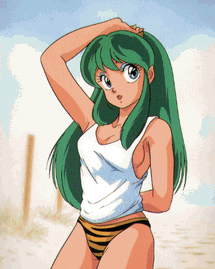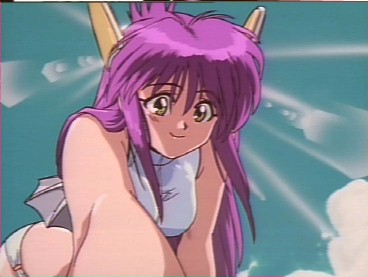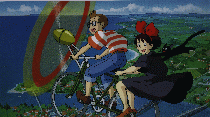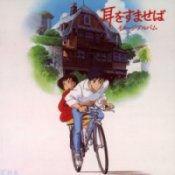Optimal viewing resolution at 800x600
pixels
Hayao Miyazaki and the Anime Art Style
Hayao Miyazaki is by far one of Japan's best known animators. Although
he is primarily a storywriting and film director nowadays, he has worked
on several of his own projects in the past, incorporating his own style
while staying within the boarders of Japanese animation (also known as
anime or japanimation). Both the Japanese culture and his own personal
life have contributed to many of his best films, including Laputa: Castle
in the Sky, Whisper of the Heart, and Kiki's Delivery Service.
Since the time when he began to work for Toei animation in 1963 to the
present, he has produced various films when topics such as Vietnam, the
landing on the Moon, and Persian Gulf War, and the breakup of the Soviet
Union were on the world's mind.
have contributed to many of his best films, including Laputa: Castle
in the Sky, Whisper of the Heart, and Kiki's Delivery Service.
Since the time when he began to work for Toei animation in 1963 to the
present, he has produced various films when topics such as Vietnam, the
landing on the Moon, and Persian Gulf War, and the breakup of the Soviet
Union were on the world's mind.
Miyazaki's Life
Hayao Miyazaki was born in Akebono-cho, a town in the Bunkyo-ku district
of Tokyo on January 5, 1941. His father, Katsuji Miyazaki (born around
1915 and died 1993), was a director of a major airplace manufacturer named
Miyazaki Airplanes, owned by Hayao's uncle (and Katsuji's older brother).
Not much is known about Hayao's mother, although she did die in 1955 from
spinal tuberculosis. Besides Hayao, Katsuji and his wife had other children,
namely, Arata (Hayao's older brother), Yutaka, and Shirou.
When he was young,
his family was evacuated to various areas during the last years of the
Empire of Japan and World War II. After being evacuated from Akebono in
1944, the Miyazaki family moved to Utsunomiya City and later Kanuma City,
the location of Miyazaki Airplanes. Afterwards, they lived in the Suginami-ku
district and stayed in 1946. The next time Hayao would move would be in
1969 to the Nerima district in Tokyo.
Hayao Miyazaki
first became interested in the comics industry when he was attending Toyotama
High School. In his third year, he watched the very first Japanese feature-length
color animated film, also called anime (ah-NEE-may), called Hakuja
Den. Later, he became an in-betweener for Toei Animation and then led
labor disputes later in his career. During this time, he met Isao Takahata,
ex-vice-chairman of Toei Douga's labor union, a friend who is now a co-filmmaker.
Soon after, Miyazaki-san dated fellow animator Atemi Ota and married her
in October 1965. Their first son was born in January 1967 and a second
son in April of 1969.
During the
time he worked at Toei, he developed a style that has both motifs present
in all forms of japanimation and also has some of his own originality in
it. Anime orginally came from manga, Japanese comics that reflect
the same style. Despite the surreally distorted face and in some cases,
body, there is real structure that underlies the exaggeration.
Techniques of Anime and Manga
The face is one of the most obviously distorted and yet does have proportion.
As in real faces, the eyes lie in the middle of the head. (Listen, I'm
revealing the secrets of anime artistry to you novices!) Most of the time,
the region above the eyes is partly or totally coved by bangs of hair.
This hair can vary from normal colors to outlandish, but the only reason
for that was because many artists were bored with only drawing characters
with dark, brown, or blond hair (in manga, the artists could only
have black and white, see?) Some examples of other hair are bright red
hair, purple hair, blue, and even green hair. The facial mass' propotions, the area with eyes, mouth, and nose, are heavily
dependent on how large the eyes are. As always there is some room for variations,
but most anime artists stay with this rule.
The facial mass' propotions, the area with eyes, mouth, and nose, are heavily
dependent on how large the eyes are. As always there is some room for variations,
but most anime artists stay with this rule.
The rest of the body is normally built in comic figure propotions, around
seven heads high. Normal proportions are sometimes used for supporting
characters that have little significance in the film. This is used to make
the viewer focus their attention on the main character.
Shadowing in anime is drawn very sharply, with at most three skin tones
to reflect value. As a result, there is limited value but the high emphasis
on shadows makes up for it. In addition, details are left out in most drawings.
Many characer do not have nostrils, nose bridges, cheekbones whilst other
details like eyebrows only appear as a single curved line above the eye.
This style is reminiscent of cartooning, but what separates anime from
the rest is the fact that it tends to approach human proportions more than
other styles. (No Elmer Fudd heads here!) When trying to express emotions,
the distortion becomes more extreme, moving away from the common, everyday
type of proportion of the human figure. Pupils and irises shrink, the mouth
can be extremely small or huge, and some details may disappear. As for
Miyazaki's own works, his style is simplistic and shadows are given less
emphasis when compared to other kinds of anime. Simple contours are commonplace,
especially in Hayao's drawings and paintings. A difference that some anime
critics notice is that Miyazaki's characters' eyes have less reflection
than most anime artists tend to place. Interestingly enough, the emotion
he expresses in his characters is not as distorted as would be exprected
in a cartoon.
Anime and Manga Mediums
The materials used in both anime and manga are essentially the same
when compared to American comics or animation. Comic artistry usually involves
drawing with india ink with an scribe pen on a drawing board with clean
drawing paper. First, pencil sketches are made and when the desired pose
is drawn, it is traced with the ink using the pen. Brushes are then used
with the ink to fill in dark areas such as shadows or dark hair. There
is no value (appearance of depth; not perspective) in manga due to the
techniques that comic artistry uses to emphasize movement.
Animation is qute different in how scenery and how the charactes are
rendered. They actual backgrounds are painted on cels, thin sheets of celluloid.
The characters and any foreground are then layered on top of the background
cells. In anime,  movement
is accomplished by simply switching cels of the characters or scrolling
the backgrounds. Anime is known for accomplishing effects with light on
the cells to produce some kind of reflection that may look like sunlight
rays, adding depth to the piece. Besides that, the paint used for the characters
is the same used in all kinds of cel animation. Recently, computer graphics
are also responsable as means to produce other kinds of effects (a la Macross
Plus). Miyazaki-san has abstained from using computers in his works, but
in a recent interview, he stated that he just hasn't seen a meaningful
application of technology necessary. The only exception is in Whisper
of the Heart (when Shizuku was flying in the sky with the Baron).
movement
is accomplished by simply switching cels of the characters or scrolling
the backgrounds. Anime is known for accomplishing effects with light on
the cells to produce some kind of reflection that may look like sunlight
rays, adding depth to the piece. Besides that, the paint used for the characters
is the same used in all kinds of cel animation. Recently, computer graphics
are also responsable as means to produce other kinds of effects (a la Macross
Plus). Miyazaki-san has abstained from using computers in his works, but
in a recent interview, he stated that he just hasn't seen a meaningful
application of technology necessary. The only exception is in Whisper
of the Heart (when Shizuku was flying in the sky with the Baron).
Here is a piece from Hayao's
work Laputa- Castle in the Sky. In this shot, a boy and a girl are
standing on the edge of cliff  that
gives a panorama of a magnificent huge building. Clouds can be seen in
between the characters and the view and more of them can be seen beneath
the bridge that is shown on the right. A river also runs under a bridge
and is the covered by the clouds.
that
gives a panorama of a magnificent huge building. Clouds can be seen in
between the characters and the view and more of them can be seen beneath
the bridge that is shown on the right. A river also runs under a bridge
and is the covered by the clouds.
This picture was taken from a
cel colored with professional quality cel paint (usually acrylic, possibly
tempura). The moss, along with the grass and the stone walls has plenty
of texture and the details that produce the texture disappear as the distance
increases from the viewer. There are shadows on both the background and
the subject of the work that point toward a light source from the upper
right. The original cel's dimensions are not available, but it is likely
it is the standard 8 1/2 inch across by 11 inch down size cel (letter size).
There is a sense of realism in how the scenery is rendered by the actual
scene is very surrealistic.
The difference in the quality
of anime is most significant when comparing it to American "Saturday
morning" cartoons. While most anime is drawn at at least 15 to 20
cels per second for television broadcast, many of the U.S. cartoons are
down at only five cels per second. The result of adding a higher frame
rate is the movement appears more life like. In addition, adding more cels
for backgrounds allows for amazing "scrolling" effects. The moutains
in the distance may move more slowly compared to foreground that moves
much faster as the drawn character exhibits movement.
Despite the differences,
there are excellent examples of animation here in the U.S. Walt Disney's
Snow White was hailed as one of the best films of our time. Today,
with the assitance of computer graphics, it made possible some of Disney's
most recent films such as Aladdin and Beauty and the Beast.
Just as the best films here are based on fairy-tale folklore, anime is
sometimes related to ancient legends in their mythology. The best animated
films from both countries run at around 30 frames per second, producing
fluid motion that makes the subject all that more real to the viewer.
Personally, analyzing Hayao's
animation gives us insight into how it can stray away from the traditional
form of Japanese animation. Hayao's personal style reflects a mix of both
American and Japanese styles, as well as themes, in his work. It is difficult
to critique animation, however, due to the fact that the many thousands
of cels can make critics dismiss this as simple an art form that lacks
artistic value. The truth is that, because animation is also used as a
storytelling medium, much of the artistic value needs to be contributed
to both what is painted and what the story is about.
Revised by Sir
Sanjiyan of the Knights of the Anime
'Round
Please visit Sanjiyan's
Gate to Konron
Taken from The Anime Art Form of Hayao Miyazaki (April 22, 1997)
by Elton Sanchez.
Revised June 17, 1997.
 Some
Miyzaki screen shots (click to see full size):
Some
Miyzaki screen shots (click to see full size):
|

Kiki's Delivery Service
|

Only Yesterday
|

Whisper of the Heart (1995 | image CD cover)
|
Bibliography:
The Miyazaki Web, http://www.nausicaa.net/~miyazaki
Wizard Magazine, How to Draw in the 'Manga Style', April 1997, pp.
72-76.
Ming's Javascipt-powered Anime Page, http://looney.physics.sunysb.edu/~daffy/anime.html
Picture Sources:
Special Note: As all great Miyazaki fans know, all of the
films that have been released by Tokuma in Japan are to be released here
in the U.S. and the U.K. by Walt Disney Pictures. The among the first films
to be released is Kiki's Delivery Service, starting in September.
Celebrate July 23rd as the official day when Miyazaki-san no anime
makes it here to the Western world!
Legal Stuff:
Shots from other anime series have been included
to illustrate anime techniques.
Snow White and Beauty and the Beast are copyrighted Walt
Disney Pictures.
Whisper of the Heart, Laputa- Castle in the Sky, and Kiki's Delivery
Service are copyright Studio Ghibli
and distributed by Tokuma and Walt Disney Pictures.
 have contributed to many of his best films, including Laputa: Castle
in the Sky, Whisper of the Heart, and Kiki's Delivery Service.
Since the time when he began to work for Toei animation in 1963 to the
present, he has produced various films when topics such as Vietnam, the
landing on the Moon, and Persian Gulf War, and the breakup of the Soviet
Union were on the world's mind.
have contributed to many of his best films, including Laputa: Castle
in the Sky, Whisper of the Heart, and Kiki's Delivery Service.
Since the time when he began to work for Toei animation in 1963 to the
present, he has produced various films when topics such as Vietnam, the
landing on the Moon, and Persian Gulf War, and the breakup of the Soviet
Union were on the world's mind. The facial mass' propotions, the area with eyes, mouth, and nose, are heavily
dependent on how large the eyes are. As always there is some room for variations,
but most anime artists stay with this rule.
The facial mass' propotions, the area with eyes, mouth, and nose, are heavily
dependent on how large the eyes are. As always there is some room for variations,
but most anime artists stay with this rule. movement
is accomplished by simply switching cels of the characters or scrolling
the backgrounds. Anime is known for accomplishing effects with light on
the cells to produce some kind of reflection that may look like sunlight
rays, adding depth to the piece. Besides that, the paint used for the characters
is the same used in all kinds of cel animation. Recently, computer graphics
are also responsable as means to produce other kinds of effects (a la Macross
Plus). Miyazaki-san has abstained from using computers in his works, but
in a recent interview, he stated that he just hasn't seen a meaningful
application of technology necessary. The only exception is in Whisper
of the Heart (when Shizuku was flying in the sky with the Baron).
movement
is accomplished by simply switching cels of the characters or scrolling
the backgrounds. Anime is known for accomplishing effects with light on
the cells to produce some kind of reflection that may look like sunlight
rays, adding depth to the piece. Besides that, the paint used for the characters
is the same used in all kinds of cel animation. Recently, computer graphics
are also responsable as means to produce other kinds of effects (a la Macross
Plus). Miyazaki-san has abstained from using computers in his works, but
in a recent interview, he stated that he just hasn't seen a meaningful
application of technology necessary. The only exception is in Whisper
of the Heart (when Shizuku was flying in the sky with the Baron). that
gives a panorama of a magnificent huge building. Clouds can be seen in
between the characters and the view and more of them can be seen beneath
the bridge that is shown on the right. A river also runs under a bridge
and is the covered by the clouds.
that
gives a panorama of a magnificent huge building. Clouds can be seen in
between the characters and the view and more of them can be seen beneath
the bridge that is shown on the right. A river also runs under a bridge
and is the covered by the clouds. Some
Miyzaki screen shots (click to see full size):
Some
Miyzaki screen shots (click to see full size):


